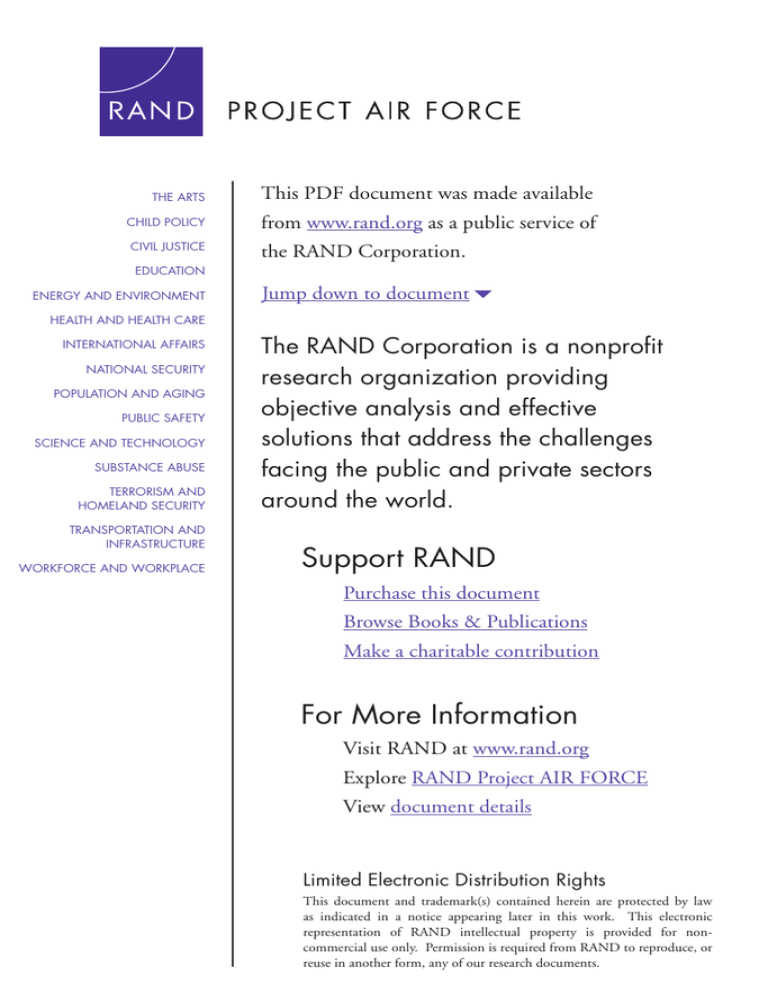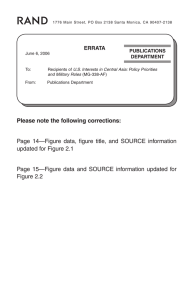
THE ARTS
This PDF document was made available
CHILD POLICY
from www.rand.org as a public service of
CIVIL JUSTICE
the RAND Corporation.
EDUCATION
ENERGY AND ENVIRONMENT
Jump down to document6
HEALTH AND HEALTH CARE
INTERNATIONAL AFFAIRS
NATIONAL SECURITY
POPULATION AND AGING
PUBLIC SAFETY
SCIENCE AND TECHNOLOGY
SUBSTANCE ABUSE
TERRORISM AND
HOMELAND SECURITY
TRANSPORTATION AND
INFRASTRUCTURE
WORKFORCE AND WORKPLACE
The RAND Corporation is a nonprofit
research organization providing
objective analysis and effective
solutions that address the challenges
facing the public and private sectors
around the world.
Support RAND
Purchase this document
Browse Books & Publications
Make a charitable contribution
For More Information
Visit RAND at www.rand.org
Explore RAND Project AIR FORCE
View document details
Limited Electronic Distribution Rights
This document and trademark(s) contained herein are protected by law
as indicated in a notice appearing later in this work. This electronic
representation of RAND intellectual property is provided for noncommercial use only. Permission is required from RAND to reproduce, or
reuse in another form, any of our research documents.
This product is part of the RAND Corporation monograph series.
RAND monographs present major research findings that address the
challenges facing the public and private sectors. All RAND monographs undergo rigorous peer review to ensure high standards for
research quality and objectivity.
Finding the Balance
Between Schoolhouse
and On-the-Job
Training
Thomas Manacapilli, Alexis Bailey, Christopher Beighley,
Bart Bennett, Aimee Bower
Prepared for the United States Air Force
Approved for public release; distribution unlimited
The research described in this report was sponsored by the United States
Air Force under Contract F49642-01-C-0003 and FA7014-06-C-0001.
Further information may be obtained from the Strategic Planning
Division, Directorate of Plans, Hq USAF.
Library of Congress Cataloging-in-Publication Data
Finding the balance between schoolhouse and on-the-job training /
Thomas Manacapilli ... [et al.].
p. cm.
Includes bibliographical references.
ISBN 978-0-8330-4045-9 (pbk. : alk. paper)
1. Aeronautics, Military—Study and teaching—United States. 2. United States.
Air Force. Air Education and Training Command—Evaluation.
I. Manacapilli, Thomas.
UG638.F55 2007
358.4'150973—dc22
2007011616
The RAND Corporation is a nonprofit research organization providing
objective analysis and effective solutions that address the challenges
facing the public and private sectors around the world. RAND’s
publications do not necessarily reflect the opinions of its research clients
and sponsors.
R® is a registered trademark.
© Copyright 2007 RAND Corporation
All rights reserved. No part of this book may be reproduced in any
form by any electronic or mechanical means (including photocopying,
recording, or information storage and retrieval) without permission in
writing from RAND.
Published 2007 by the RAND Corporation
1776 Main Street, P.O. Box 2138, Santa Monica, CA 90407-2138
1200 South Hayes Street, Arlington, VA 22202-5050
4570 Fifth Avenue, Suite 600, Pittsburgh, PA 15213-2665
RAND URL: http://www.rand.org/
To order RAND documents or to obtain additional information, contact
Distribution Services: Telephone: (310) 451-7002
Fax: (310) 451-6915; Email: order@rand.org
Summary
How should enlisted initial training be divided between centralized initial skills training (IST) and decentralized on-the-job training (OJT)? This document provides recommendations to address this
question based on a cost-benefit analysis of seven Air Force specialties.
The underlying methodology includes a mechanism for developing
specialty learning and productivity curves that are used to capture the
full human capital development (HCD) cost (IST and OJT). All too
often, only IST costs are considered when “pricing” training. When
this is done, the overall cost to train an airman is seriously underestimated. When the full costs are considered, decisions related to the
length of IST are better informed.
The Air Force typically trains 30,000 to 40,000 new airmen in
some 300 specialties each year. We estimate IST costs at $700 million per year, with OJT costs reaching perhaps $1.4 billion each year.
In developing new airmen to required levels of productivity, IST and
OJT can, to some degree, substitute for each other. An appropriately
designed cost-benefit analysis is necessary to find the best balance
between them.
Productivity is difficult to measure. We equate a productive
airman with one who possesses the skills to be fully mission capable.
But then, in what ways must an airman in a particular specialty be
skilled in order to be fully mission capable? How should a training
program prepare airmen to obtain these skills and this experience? At
what skill level do airmen currently graduate from IST? How does productivity increase with time in OJT?
xv
xvi
Finding the Balance Between Schoolhouse and On-the-Job Training
To answer these questions, we fielded a survey among E-6s1 and
above from each of seven Air Force specialties2 in four of the major
commands (MAJCOMs)3 in order to determine the effectiveness of the
current IST and OJT training programs. A portion of the questions
was designed to elicit the manner in which IST prepares airmen and
how OJT increases productivity over time. We statistically averaged
the responses and created the productivity curves shown in Figure S.1.
Using these curves, we were able to decompose force costs into two
parts: costs associated with productive effort (the proportion below the
curve) and HCD costs (the proportion above the curve).
How does productivity change when IST course length changes?
To make this assessment, we again relied on survey respondents to estimate the impact in both time and productivity. Unlike other attempts
to determine the result of marginal (1-, 2-, or 3-day) changes in IST
course length, we chose to request specific course material that could
be added or deleted, the associated change in the course length, and
the corresponding increase or decrease in productivity at graduation.
For example, Figure S.2 shows curves statistically generated to fit the
survey responses. Note that most of these curves increase initially but
then level off, indicating that course lengths longer than a certain
number of days will have diminishing impacts on productivity.
In our final methodological step, we combine the productivity
curves with the course length changes and costs to examine total HCD
costs. Costs include personnel cost, initial skills and advanced training costs, and other OJT-related costs, such as equipment and supervisor time. We use manpower data to determine the average number of
1 Because of the small numbers in the airborne linguist (1A8X1) and cryptologic linguist
(1N3XX) specialties, we also included E-5s from the 1N3XX specialty and E-4s and E-5s
from the 1A8X1 specialty. The grades E-6 and above are primarily supervisors.
2
Airborne Cryptologic Linguist (AFSC 1A8X1); Cryptologic Linguist (AFSC 1N3XX);
Tactical Aircraft Maintenance, F-15 (AFSC 2A3X3A); Aerospace Maintenance, B-1/B-2
(AFSC 2A5X1E); Special Purpose Vehicle Maintenance (AFSC 2T3X1); Fire Protection
(AFSC 3E7X1); and Security Forces (AFSC 3POX1).
3
Air Combat Command, Air Mobility Command, Air Force Space Command, and Air
Education and Training Command. Discussions with subject matter experts indicated that
the selected MAJCOMs would provide an adequate sample of experiences for these AFSCs.
Summary
xvii
Figure S.1
Comparison of Fitted Productivity Curves
100
90
Productivity (%)
80
70
60
2A5X1E
2A3X3A
2T3X1
3P0X1
3E7X1
1N3XX
1A8X1
50
40
30
20
10
0
0
1
2
3
4
5
6
YOS
NOTE: 1A8X1 = Airborne Cryptologic Linguist; 1N3XX = Cryptologic Linguist;
2A3X3A = F-15 Maintenance; 2A5X1E = B-1/B-2 Maintenance; 2T3X1 = Special
Purpose Vehicle Maintenance; 3E7X1 = Fire Protection; 3POX1 = Security Forces.
RAND MG555-S.1
airmen in each year of service. Combining the data, we can examine
trade-offs among manpower, productivity, and cost.
Applying our analysis to the seven selected specialties, we achieved
the results described in Table S.1. Our analysis of the survey responses
was performed on a variety of dimensions. In addition to quantitative results, we included a qualitative analysis of comments from the
survey respondents. Column 3, “Write-in Comments,” summarizes
free-response comments to questions suggesting course changes. The
“Add vs. Drop” column is a comparison of the number of responses to
specific questions on adding and deleting course content. The “Incremental Change Functions” column provides the direction of the average change in productivity for suggested changes to IST. The “Steady
State Analysis” column summarizes the results of the steady state costbenefit analysis.
xviii
Finding the Balance Between Schoolhouse and On-the-Job Training
Figure S.2
Changes in Productivity as a Function of Changes in Course Length
3P0X1
2A3X3A
3E7X1
2T3X1
2A5X1E
1A8X1
1N3XX
14
Change in productivity
(percentage points)
12
10
8
6
4
2
0
0
5
10
15
20
Change in IST course length (days)
NOTE: 1A8X1 = Airborne Cryptologic Linguist; 1N3XX = Cryptologic Linguist;
2A3X3A = F-15 Maintenance; 2A5X1E = B-1/B-2 Maintenance; 2T3X1 = Special
Purpose Vehicle Maintenance; 3E7X1 = Fire Protection; 3POX1 = Security Forces.
RAND MG555-S.2
We recommend that the utilization and training workshops
(U&TWs) for each of the specialties perform a closer examination of
IST course length changes that appear to lower overall HCD costs
for the same or greater productivity. For AFSCs 1A8X1 and 1N3XX,
there is strong evidence that reductions in the course length would
result in only a small reduction in immediate productivity of graduates. For the other specialties, we believe a lower overall HCD cost per
unit of productivity can be achieved by increasing course length. (See
pp. 45–49.)
The seven specialties specifically examined in this study offer
prototypes for our overall methodology. One essential element is
the derivation of productivity curves. The Air Force’s Occupational
Summary
xix
Table S.1
Analysis Summary
Add vs.
Drop
Comparison
Incremental Steady
Change
State
Functions Analysis
Specialty
Title
Write-In
Comments
1A8X1
Airborne
Cryptologic
Linguist
Don’t
add
1N3XX
Cryptologic
Linguist
2T3X1
Special
Purpose
Vehicle
Maintenance
Increase
Increase
2A3X3A
F-15 Tactical
Aircraft
Maintenance
Increase
Increase
2A5X1E
B-1/B-2
Aerospace
Maintenance
Don’t
drop
Add
Increase
Increase
3P0X1
Security
Forces
Don’t
drop
Add
Increase
Increase
3E7X1
Fire
Protection
Add
Increase
Don’t
decrease
Increase
AFSC
Drop
Decrease
Drop
Decrease
Measurement Squadron (OMS) measures certain aspects of productivity through its occupational measurement surveys. We recommend
that AETC investigate the use of current OMS tools and potential
enhancements to develop productivity curves and the functional relationship between incremental changes in IST content, course length,
and graduation effectiveness. We also recommend that the AETC
Studies and Analysis Squadron use our HCD cost model and methodology for future IST course length studies. Other specialties can
be readily examined. Improvements in methodology might include
greater fidelity in generating the productivity curves, determining the
impact of curriculum changes, and estimating costs. (See pp. 30–35
and 57–64.)
Finally, this analysis approach offers great potential for trades. In
three of the AFSCs (2T3X1, 3P0X1, and 3E7X1), a 0.5-percent change
xx
Finding the Balance Between Schoolhouse and On-the-Job Training
in total costs for increasing course length resulted in a tenfold (5.0percent) change in total productivity. (See pp. 63 and 67.)
In summary, our analysis suggests the following:
• A significant increase in productivity for small addition in IST course
length is likely to exist for five of the seven specialties we analyzed.
(See pp. 63 and 67.)
• In some cases, portions of the IST curriculum could be reduced with
little impact on productivity. We believe there is evidence from the
qualitative responses for considering reductions in the 1A8X1 and
1N3XX specialties. (See pp. 47–49.)
• Although we believe these increases are plausible given the way
we conducted the analysis, it would be prudent to replicate the data
with more specific and refined survey estimates. (See pp. 70–71.)
• The Air Force should also investigate other external measures to
validate the productivity functions we derived. (See pp. 23–31
and 71.)
• This analysis also demonstrates the large role played by the cost of
OJT and its importance in policymaking, particularly for determining the course length of IST. (See pp. 62–68.)
• We recommend that the specific results of this analysis should be
briefed to the respective AFSC U&TWs as they consider the suitability of the current IST curricula. (See pp. 57–68.)
• Finally, we recommend that the AETC Studies and Analysis Squadron (SAS) adopt the models and methodology developed in this study
for future analyses involving the length of IST. (See pp. 57–68.)






